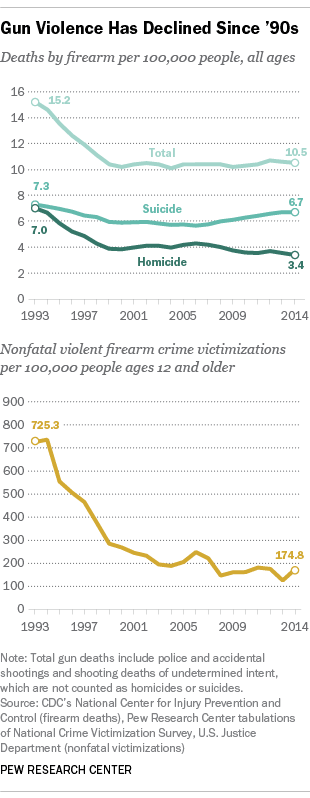The following statistics are taken from the CDC "National Vital Statistics Reports, Volume 66, Number 6, Deaths: Final Data for 2015" published November 27, 2017. In 2015 there were 36,252 firearm related deaths. Of those, 22,018 were suicides. 487 were unintentional. For 2014, the same report shows 33,594 total firearm related deaths, 21,386 firearm related suicides and 461 unintentional deaths. I am giving both years because although 2015 is the latest data published by the CDC, 2014 is the latest data published by the FBI and I want to match data from the same year.
According to the FBI "Expanded Homicide Data Table 8" for 2014 (this is the latest data available at this time) there were 248 homicides committed with rifles in the United States. An additional 1,959 homicides did not report the type of firearm used. Assuming the same breakdown of firearm type for these records we'd have an addition 79 homicides with a rifle, for a total number of homicides by rifle of 327 for the entire year.
We don't know what kind of rifles, as the data isn't broken down by type, but let's assume 100% of those deaths were by "assault weapon" style rifles. So an "assault weapon" ban could save at most 327 lives out of 33,594, or under 1% difference. According to this article using the highest estimate of the number of AR-15 style rifles sold in the US, at most 20% of rifles are AR-15 style. So we're looking at maybe affecting 65 homicides, per year, a difference of 0.2% or less (assuming the murderers decided not to commit murder rather than using a different weapon).
That does not look like we are solving the "gun violence" problem, does it?
In 1994 the US federal government passed an assault weapons ban - nation-wide. In 2004 it expired. Reports analyzing the homicide rate over those ten years determined what we just did above (and we didn't have to spend billions and violate people's rights to do it) - the ban had no effect on homicides. Of course, the anti-gunners were quick to point out that we needed to do it more to see any effect - because apparently when something doesn't work, it's not really not working.
Fourteen years after the ban expired, the firearm homicide rate is even lower than it was in 2004 when it the assault weapons ban was in effect. So why are we even discussing re-implementing one?
At the top of this article I mentioned suicides. If we look at the the number of firearm suicides, not just homicides, since 1990, we see that although the overall firearm death rate is down (from 15.2 to 10.6 per 100,000), and the firearm homicide rate has gone way down more than 50% (from 7.0 to 3.4) the suicide rate has remained relatively steady (and is actually on the rise).
Since most firearm deaths are suicides and since the rate is increasing, wouldn't it be more logical to focus on mental health and suicide prevention than on banning AR-15s? Even a small impact on the number of firearm suicides would save many more lives than an assault weapons ban could ever hope to save.
To find the rest of the posts in this series click here.












0 comments:
Post a Comment